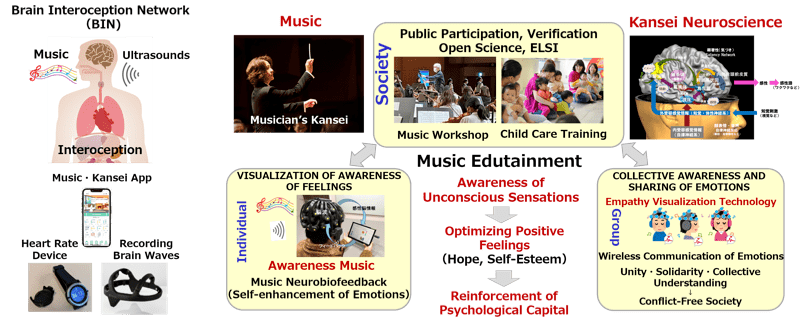R&D Project

Goal 9 R&D ProjectsInnovation in “Mental Capital” through Awareness Music and creation of new liberal arts
Project manager (PM)YAMAWAKI ShigetoHiroshima University Center for Brain, Mind and Kansei Sciences Research Specially Appointed Professor
Summary of the project
In the Metaverse society of 2050, where reality and virtual space will merge, there are concerns about social issues related to the emergence of novel mental health problems due to the lack of direct social communication and real experiences (physical sensations). In this project, we will elucidate the effects of music on the generation of positive emotions, psychological healing, and a sense of self-unity from a neuroscientific perspective.
Focusing on interoceptive predictive control in the brain we will seek to understand the 1) Emergence of Awareness Music including Natural Sound and interoceptive awareness (latent KANSEI) using music and ultra-high frequency sounds, 2) Develop devices to visualize KANSEI and Awareness Music, 3) Use Neurobiofeedback (NBF) to positively modulate KANSEI and develop technology to improve psychological capital such as hope and efficacy, 4) Develop a KANSEI Communication technology to support the promotion of Empathy.
All research and technology developed in this project will be open to the public and its implementation in society will be discussed regarding its ethical, legal and social issues. We will create an academic model of a new liberal arts (comprehensive knowledge) through interdisciplinary research projects that integrates music, brain science, information science, and developmental science.
*KANSEI: Japanese original sensibility based on Japanese culture
*Interoception: neural sensation of information inside the body (visceral senses, immunity, endocrine, etc.)
Milestones for Year 2032
- Provide services of “enhancement of psychological capital” and “emotional communication” that nurture one’s own KANSEI and empathy with others (change childcare, education, and society).
- Create a comprehensive arts and sciences academic program (Music Edutainment) with a focus on understanding the effects of music on the brain and mind, and provide an academic model for the new liberal arts (culture, entertainment and learning).
Milestones for Year 2027
- Visualization of KANSEI promotes awareness of one's own unconscious positive KANSEI, enabling basic technology to nurture and enrich KANSEI.
- Develop technologies to help reverse negative emotional states caused by stress (disappointment, loss of self-confidence, etc.) into positive emotional states promoted by the effects of music and sound on awareness, impression, and healing.
R&D theme progress reports
- 1. Promotion of research innovation by fusion of music and brain
- 2. Construction and social implementation of a research platform for Music and KANSEI Brain Science Research for all citizens
- 3. Dynamics of integrating interoception and exteroception in parent–infant musical engagement
- 4. Elucidation of mechanisms to promote awareness of internal receptive sensation of inaudible high-frequency sounds and its social implementation.
- 5. Identification of Awareness Music/Sound and the AMS Effects of Sensitive Period
- 6. Investigation to elucidate the KANSEI mechanism and to develop its brain scientific model based on the analyses of simultaneous fMRI-EEG-BIN measurement data
- 7. Remote KANSEI Quantification with Wearable BIN system & Music-based Neuro-Bio-Feedback
R&D theme structure of the project
- romote innovation by interdisciplinary fusion of music and KANSEI neuroscience (PI: YAMAWAKI Shigeto, Hiroshima University).
- articipation of individuals with music experience, KANSEI Brain Science Open Science, ELSI, demonstration and verification of findings and social implementation (PI: NISHIMOTO Tomomi, Hiroshima University).
- lucidation of the developmental mechanism of interoception in infants by music and its social implementation (PI: MYOWA Masako, Kyoto University).
- lucidation of the neural mechanisms that promote interoceptive awareness by music and ultrasounds and the emergence of Awareness Music (PI:HONDA Manabu , NCNP; TAKAHASHI Hirokazu, University of Tokyo).
- ropose a neurobiologically plausible model of Kansei and develop novel technologies to visualize and modulate (NFB) the mechanisms of brain-interoception representation (PI:SASAOKA Takafumi and MACHIZAWA Maro, Hiroshima University).

- <Image shows a hypothetical society of the future>
- [Individual] Reinforcement of "psychological capital" based on neuroscientific evidence and visualization technology for realizing and optimizing positive KANSEI ( hope, efficacy, resilience, optimism) by music/sound.
- [Group] Establishment of Music Edutainment using visualization technology to synchronizing multiple people's KANSEI (sense of unity, mutual understanding) through music/sound and strengthening of group's "psychological capital."
- [Society] Realization of a conflict-free society and creation of a new model of Liberal Arts with a focus on Empathy and KANSEI using music/sound awareness and visualization technologies.
Leader's institution
Hiroshima University
R&D institutions
Kyoto University, National Center of Neurology and Psychiatry, Tokyo University, Hiroshima University
PDF Download
- Summary of the project (288KB)
- Progress Report (Download all) (1.89MB)